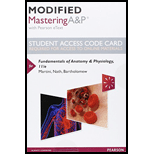
Modified Mastering A&P with Pearson eText -- Standalone Access Card -- for Fundamentals of Anatomy & Physiology (11th Edition)
11th Edition
ISBN: 9780134509181
Author: Frederic H. Martini, Judi L. Nath, Edwin F. Bartholomew
Publisher: PEARSON
expand_more
expand_more
format_list_bulleted
Concept explainers
Question
Chapter 2, Problem 1CC
Summary Introduction
To determine:
The undigested food that made baby Sean’s stools greasy and foamy.
Introduction:
The affected baby is diagnosed with cystic fibrosis, in which the ability to transport of NaCl into and out of the cells, is absent. This is a genetic disorder which provides a faulty gene to the child. Due to absence of NaCl, many activities of the body are hampered such a digestion and respiration due to clogging of cells. The sweat releases the excess salt and the skin always has high salt concentration.
Expert Solution & Answer
Want to see the full answer?
Check out a sample textbook solution
Students have asked these similar questions
Why Cyanide Is So Deadly?
How many grams of glucose would you need to make 500 mL of an 8% solution?
What would happen if:
The alcohol was left on for 20 minutes?
The safranin was added after addition of the iodine?
The addition of iodine was omitted?
Chapter 2 Solutions
Modified Mastering A&P with Pearson eText -- Standalone Access Card -- for Fundamentals of Anatomy & Physiology (11th Edition)
Ch. 2 - Define atom.Ch. 2 - Atoms of the same element that have different...Ch. 2 - How is it possible for two samples of hydrogen to...Ch. 2 - Prob. 4CPCh. 2 - Prob. 5CPCh. 2 - Both oxygen and neon are gases at room temperature...Ch. 2 - Prob. 7CPCh. 2 - Prob. 8CPCh. 2 - Prob. 9CPCh. 2 - Prob. 10CP
Ch. 2 - What is an enzyme?Ch. 2 - Prob. 12CPCh. 2 - Prob. 13CPCh. 2 - Explain how the chemical properties of water make...Ch. 2 - Define pH, and explain how the pH scale relates to...Ch. 2 - What is the significance of pH in physiological...Ch. 2 - Define the following terms: acid, base, and salt.Ch. 2 - Prob. 18CPCh. 2 - Prob. 19CPCh. 2 - Which functional group acts as an acid?Ch. 2 - Prob. 21CPCh. 2 - Describe lipids.Ch. 2 - Prob. 23CPCh. 2 - Prob. 24CPCh. 2 - Prob. 25CPCh. 2 - Describe a nucleic acid.Ch. 2 - Prob. 27CPCh. 2 - Describe ATP.Ch. 2 - What molecule is produced by the phosphorylation...Ch. 2 - An oxygen atom has eight protons (a) Sketch in the...Ch. 2 - What is the following type of decomposition...Ch. 2 - The subatomic particle with the least mass (a)...Ch. 2 - Isotopes of an element differ from each other in...Ch. 2 - The number and arrangement of electrons in an...Ch. 2 - All organic compounds in the human body contain...Ch. 2 - A substance containing atoms of different elements...Ch. 2 - All the chemical reactions that occur in the human...Ch. 2 - Which of the following chemical equations...Ch. 2 - Prob. 10RQCh. 2 - A pH of 7.8 in the human body typifies a condition...Ch. 2 - A(n) _____ is a solute that dissociates to release...Ch. 2 - Special catalytic molecules called _____ speed up...Ch. 2 - Which of the following is not a function of a...Ch. 2 - Complementary base pairing in DNA includes the...Ch. 2 - What are the three subatomic panicles in atoms?Ch. 2 - Prob. 17RQCh. 2 - Prob. 18RQCh. 2 - List seven major functions performed by proteins.Ch. 2 - (a) What three basic components make up a...Ch. 2 - What three components are required to create the...Ch. 2 - If a polypeptide contains 10 peptide bonds, how...Ch. 2 - Prob. 23RQCh. 2 - Prob. 24RQCh. 2 - What is a salt? How does a salt differ from an...Ch. 2 - Prob. 26RQCh. 2 - In an exergonic reaction, (a) large molecules are...Ch. 2 - Prob. 28RQCh. 2 - Prob. 29RQCh. 2 - An atom of the element calcium has 20 protons and...Ch. 2 - A certain reaction pathway consists of four steps....Ch. 2 - Prob. 32RQCh. 2 - Prob. 1CCCh. 2 - Prob. 2CC
Knowledge Booster
Learn more about
Need a deep-dive on the concept behind this application? Look no further. Learn more about this topic, biology and related others by exploring similar questions and additional content below.Similar questions
- How do you think alcoholic beverages of alcohol content greater than this concentration are obtained?arrow_forwardWhy does a valid comparison between mono - and disaccharides require their solution to be of similar concentration?arrow_forwardWhat type of lipid I shown in the picture believe?arrow_forward
arrow_back_ios
arrow_forward_ios
Recommended textbooks for you
- Essentials of Pharmacology for Health ProfessionsNursingISBN:9781305441620Author:WOODROWPublisher:Cengage

Essentials of Pharmacology for Health Professions
Nursing
ISBN:9781305441620
Author:WOODROW
Publisher:Cengage
Drug Abuse, Causes, Signs and Symptoms, Diagnosis and Treatment.; Author: Medical Centric;https://www.youtube.com/watch?v=b6Dte96WdqM;License: Standard youtube license